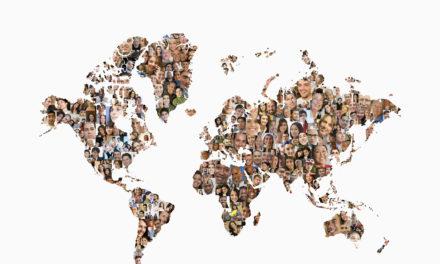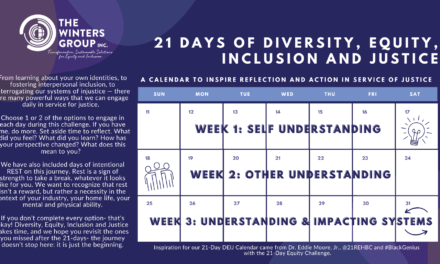
Sometimes it can feel like we don’t have the authority, power, or capacity to create change within our organizations due to our title or role. For instance, how exactly can a graphic designer, or someone in product development or marketing operations, create equity? Fortunately, even those who don’t have a formal or traditional DEI role have many opportunities to build more equitable, just, and inclusive policies and procedures.
In my chapter in Racial Justice at Work: Practical Solutions for Systemic Change, I discuss specific opportunities for marketers to embed equity and justice into their work. One component of the DEIJ alphabet that often gets overlooked is the “A”– accessibility. (In this case, I’m using “accessibility” to refer not only to equity for people with disabilities, but also the broader sense of who in society has access to and benefits from full participation in economic, social, and civic life.)
Since marketing has one of the most influential and significant impacts on accessibility within an organization, considering accessibility as a standard practice offers incredible opportunities for building equity, inclusion, and justice.
When considering where we can embed justice principles, accessibility is an excellent place to start. Doing so, however, requires a healthy curiosity and the initiative to question practices that are part of the status quo and to ask ourselves, “Who does this harm and how does it harm them?” With intention, we can build the muscle memory to consistently look for opportunities to rethink these systems and processes in a more equitable way.
Let’s look at five ways you can re-imagine the status quo in marketing to create more equitable products, policies, procedures, and experiences in your organization.
As a marketer, how do we create accessibility?
Price:
Organizations, even mission-driven companies and non-profits, require enough capital and cash flow to continue operating – enough to pay salaries, benefits, taxes, overhead, and the myriad other expenses needed to run an organization. The emphasis an organization puts on net profit is where there are numerous opportunities to rethink policies and the impact the system has on employees, clients, customers, and communities. This is a larger conversation, but specific aspects of price that support equity and accessibility that you may consider are:
- Offering a sliding scale or financial assistance;
- Reducing rates for historically marginalized groups, or those in specialized sectors such as non-profits, education, or other mission-driven sectors;
- Creating a mechanism where others who are able to pay full price can “pay-it-forward” and help offset costs for marginalized groups;
- Offer internal sources of funding to offset employee costs
Not all of these options are necessarily appropriate for every industry or situation, but thoughtfully considering these alternatives with a justice-lens, rather than through a dominant culture framework, can aid in creating equity and increasing access.
Payment methods and terms:
For marketing operations, simpler is better so building equity in payment methods and terms can be challenging (and stressful). For example, the credit card is often the most convenient payment method. It’s easy to set up, easy to track, and doesn’t require any careful oversight. However, not everyone has access to a credit card or has a credit limit that will accommodate larger purchases. Most companies require employees to use a personal card and submit for reimbursement, but then might delay reimbursing employees which can lead to late fees and credit repercussions. Instead, you can offer ACH bank transfers.
Alternatively, you can offer customers the ability to pay via invoice. Invoices can be routed to internal accounting departments and the employee isn’t responsible for shouldering the cost. This option can result in increased labor to process the invoices and chase down those who didn’t pay, but this small accommodation could make all the difference in whether or not someone is able to access your product or service.
Beyond payment methods, payment plans are another opportunity to create equitable policies and procedures. For larger ticket items, offering to pay over time (through any of the methods listed above) is a way to create ease and space for customers. One of my colleagues, Gabby Gonzalez, noted that making payments due on a Friday, either at the beginning or middle of the month, might be more accessible for people who are waiting for their paycheck to clear before making a payment.
Implementing one or more of these payment methods or terms will likely result in more work, either during the development phase or when processing payments. It might result in more oversight, manual work, or more complex reporting. This is the reality of creating equity. You are shifting some of the burden from those who have been historically marginalized to an organizational level.
Ease of access:
Another facet of accessibility is ease of access. If it is an online program or product, or you are promoting it online, is your website responsive? Is it clear and readable for those on a computer, tablet, or phone? According to Pew Trusts, 83% of those in the U.S. access the internet from a phone or mobile device, and for 15% of Americans, this is their only source for internet access. Mobile responsiveness is a critical focus for equity.
Do you have alternative text tags for all images on your website so that screen readers are able to describe the content and context of the images to visually-impaired visitors? More than 30% of website homepages don’t have any image tags, which can be an immediate and significant barrier to access. Do you have subtitles for your video content and ASL (or equivalent) interpreters for live events?
Often, implementing equitable practices requires additional time, expertise, and cost for an organization; however, this should be considered as part of standard marketing practice to embed accessibility and equity within systemic processes.
Readability/design:
When creating content for the web, presentations, decks, or handouts, ensure you are using accessible design principles. Start by:
- Incorporating ample blank space to give the eyes rest, or provide an alternative version of the content for those with sight issues;
- Choosing a font that is clear and easy to read;
- Using a mix of text and imagery and or iconography to help visual learners and support a neurodiverse audience.
One aspect that can be easily overlooked is color. Those who are color blind might not be able to register emphasis by color alone, so bold type, underlining, italics, and other graphic representation (boxes, arrows, circles, etc.) can make design more accessible. If you are creating digital handouts or files, is your text OCR (Optical Character Recognition)-ready? Meaning you didn’t copy text as an image, making it unrecognizable to screen readers.
I’ve often heard the design phase referred to as just “making something pretty.” Going deeper into the accessibility of design provides numerous opportunities to go beyond mere aesthetics and actually create more equitable policies and practices.
Packaging, labeling, ingredients:
For products, specifically consumer-packaged goods, consider what opportunities there are within marketing and product development to make things more accessible and equitable. For example, what is your packaging like? If it’s a tube of lotion, do you have a screw lid or is it a flip cap for people that don’t have the dexterity or the ability to twist or turn?
Think of shampoo or conditioner. Similar to the above example, designing a bottle that utilizes a pump makes it easier to use for those with mobility limitations. Similarly, using a different shape pump on the shampoo than on the conditioner makes it easier for someone with a visual impairment to tell which is which in the shower. Guide Cosmetics, designed by a makeup artist with MS, creates products that are designed to be easier to grip and hold. Access is therefore built into their product line through design.
Building equity and accessibility requires us to look beyond our own lens and consider how our products impact the hidden and unhidden identities our audience might hold. This might require us to offer alternative versions of products, or to have a higher price point for packaging or shipping to create designs that create equity.
This is, of course, by no means an exhaustive list. This just touches on the issues you can begin to consider. As you work through these issues and more, I’d love to hear from you. What opportunities are there for your organization to create alignment between equity and your products or services? What questions are you using to challenge yourself and your marketing efforts? How has it impacted the organization?


















